Annotated Bibliography: Gender Differences & Aggressive Behavior
VerifiedAdded on 2023/06/18
|6
|1010
|357
Annotated Bibliography
AI Summary
This annotated bibliography explores the nuanced relationship between gender and aggression, drawing upon three key articles. The first article examines gender differences in aggressive behavior among undergraduates, revealing that males tend to exhibit more physical aggression, while females are more prone to verbal aggression. The second article corroborates these findings, noting that women are less physically aggressive than men but may engage in more indirect forms of aggression. It also highlights the role of hormones like oxytocin and testosterone. The third article investigates the impact of aggression-evoking cues on cognitive processes in males and females, reinforcing the idea that males are more likely to exhibit physical and sexual aggression, while females display verbal and relational aggression. Overall, the bibliography suggests that aggressive behavior varies by gender and context, with both biological and social factors playing significant roles. Desklib provides access to similar solved assignments and past papers for students.

Annotated Bibliography
Paraphrase This Document
Need a fresh take? Get an instant paraphrase of this document with our AI Paraphraser
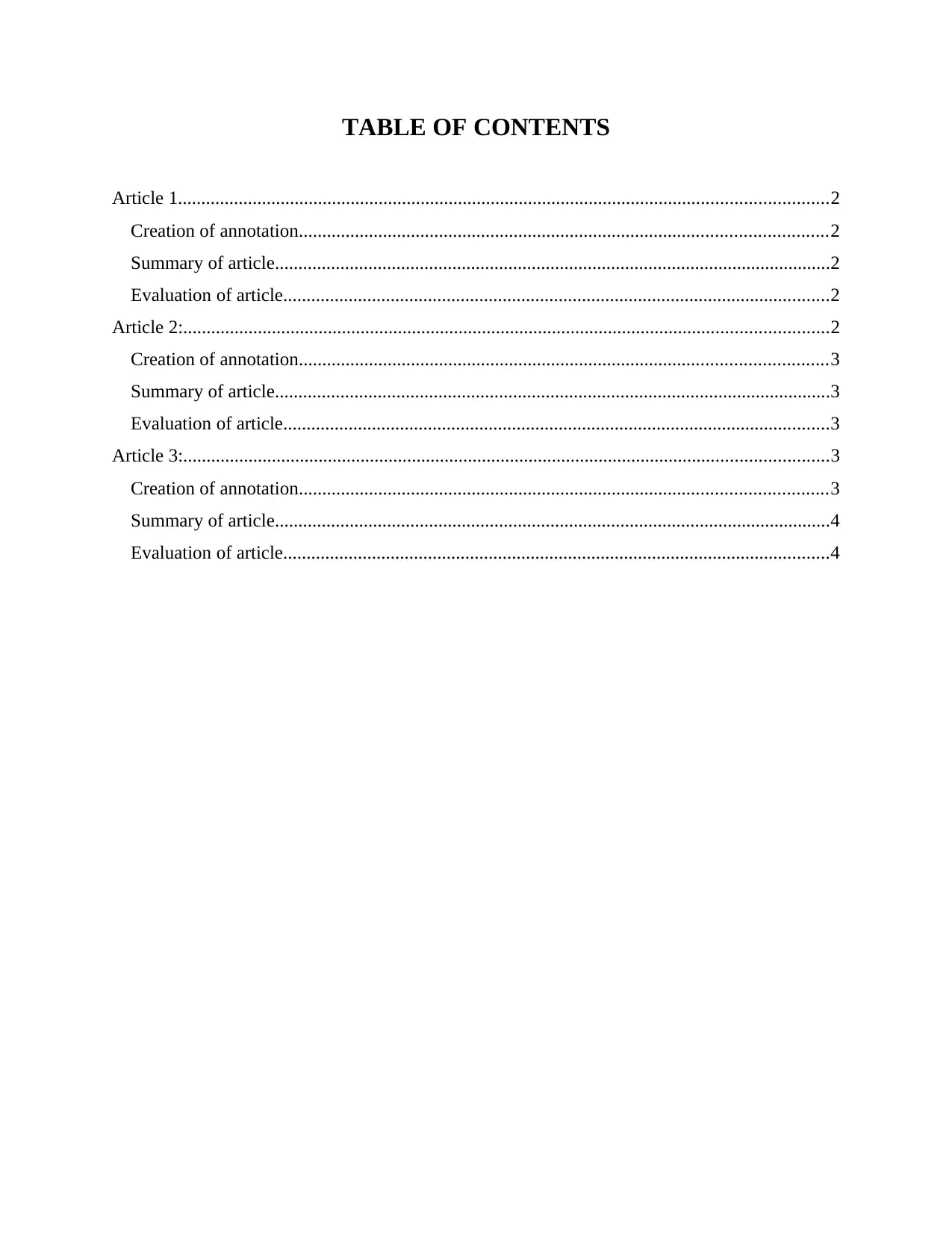
TABLE OF CONTENTS
Article 1...........................................................................................................................................2
Creation of annotation.................................................................................................................2
Summary of article.......................................................................................................................2
Evaluation of article.....................................................................................................................2
Article 2:..........................................................................................................................................2
Creation of annotation.................................................................................................................3
Summary of article.......................................................................................................................3
Evaluation of article.....................................................................................................................3
Article 3:..........................................................................................................................................3
Creation of annotation.................................................................................................................3
Summary of article.......................................................................................................................4
Evaluation of article.....................................................................................................................4
Article 1...........................................................................................................................................2
Creation of annotation.................................................................................................................2
Summary of article.......................................................................................................................2
Evaluation of article.....................................................................................................................2
Article 2:..........................................................................................................................................2
Creation of annotation.................................................................................................................3
Summary of article.......................................................................................................................3
Evaluation of article.....................................................................................................................3
Article 3:..........................................................................................................................................3
Creation of annotation.................................................................................................................3
Summary of article.......................................................................................................................4
Evaluation of article.....................................................................................................................4
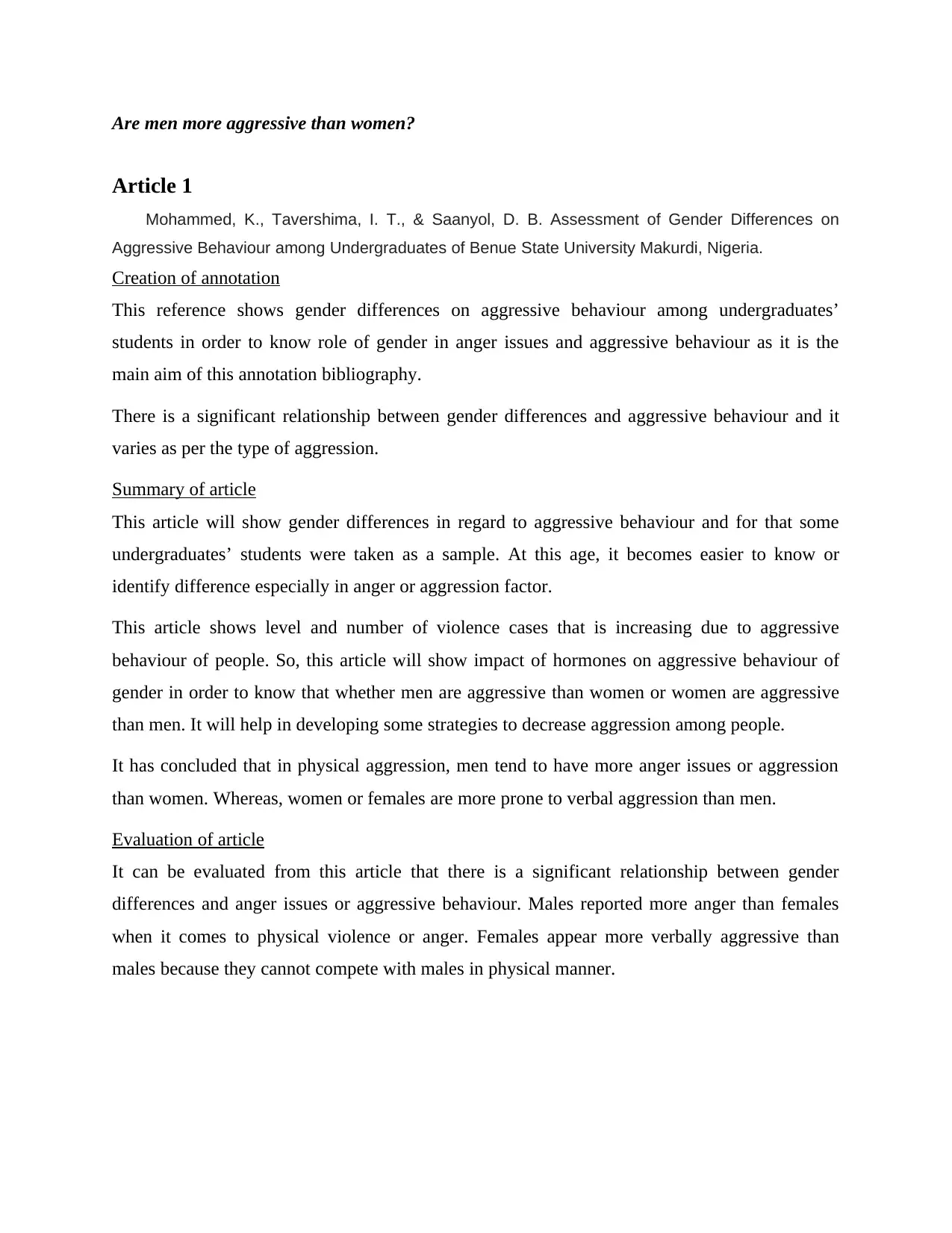
Are men more aggressive than women?
Article 1
Mohammed, K., Tavershima, I. T., & Saanyol, D. B. Assessment of Gender Differences on
Aggressive Behaviour among Undergraduates of Benue State University Makurdi, Nigeria.
Creation of annotation
This reference shows gender differences on aggressive behaviour among undergraduates’
students in order to know role of gender in anger issues and aggressive behaviour as it is the
main aim of this annotation bibliography.
There is a significant relationship between gender differences and aggressive behaviour and it
varies as per the type of aggression.
Summary of article
This article will show gender differences in regard to aggressive behaviour and for that some
undergraduates’ students were taken as a sample. At this age, it becomes easier to know or
identify difference especially in anger or aggression factor.
This article shows level and number of violence cases that is increasing due to aggressive
behaviour of people. So, this article will show impact of hormones on aggressive behaviour of
gender in order to know that whether men are aggressive than women or women are aggressive
than men. It will help in developing some strategies to decrease aggression among people.
It has concluded that in physical aggression, men tend to have more anger issues or aggression
than women. Whereas, women or females are more prone to verbal aggression than men.
Evaluation of article
It can be evaluated from this article that there is a significant relationship between gender
differences and anger issues or aggressive behaviour. Males reported more anger than females
when it comes to physical violence or anger. Females appear more verbally aggressive than
males because they cannot compete with males in physical manner.
Article 1
Mohammed, K., Tavershima, I. T., & Saanyol, D. B. Assessment of Gender Differences on
Aggressive Behaviour among Undergraduates of Benue State University Makurdi, Nigeria.
Creation of annotation
This reference shows gender differences on aggressive behaviour among undergraduates’
students in order to know role of gender in anger issues and aggressive behaviour as it is the
main aim of this annotation bibliography.
There is a significant relationship between gender differences and aggressive behaviour and it
varies as per the type of aggression.
Summary of article
This article will show gender differences in regard to aggressive behaviour and for that some
undergraduates’ students were taken as a sample. At this age, it becomes easier to know or
identify difference especially in anger or aggression factor.
This article shows level and number of violence cases that is increasing due to aggressive
behaviour of people. So, this article will show impact of hormones on aggressive behaviour of
gender in order to know that whether men are aggressive than women or women are aggressive
than men. It will help in developing some strategies to decrease aggression among people.
It has concluded that in physical aggression, men tend to have more anger issues or aggression
than women. Whereas, women or females are more prone to verbal aggression than men.
Evaluation of article
It can be evaluated from this article that there is a significant relationship between gender
differences and anger issues or aggressive behaviour. Males reported more anger than females
when it comes to physical violence or anger. Females appear more verbally aggressive than
males because they cannot compete with males in physical manner.
⊘ This is a preview!⊘
Do you want full access?
Subscribe today to unlock all pages.

Trusted by 1+ million students worldwide
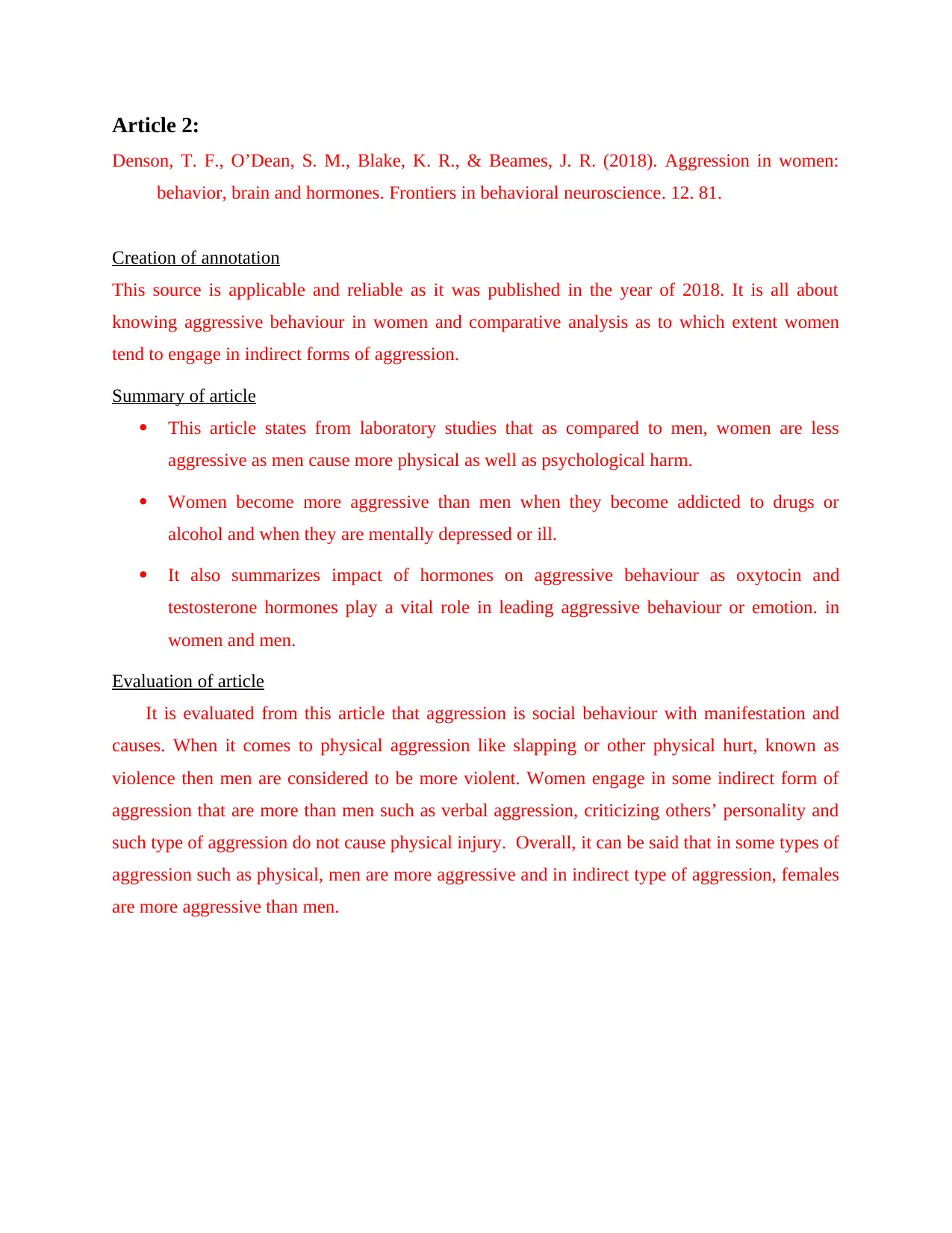
Article 2:
Denson, T. F., O’Dean, S. M., Blake, K. R., & Beames, J. R. (2018). Aggression in women:
behavior, brain and hormones. Frontiers in behavioral neuroscience. 12. 81.
Creation of annotation
This source is applicable and reliable as it was published in the year of 2018. It is all about
knowing aggressive behaviour in women and comparative analysis as to which extent women
tend to engage in indirect forms of aggression.
Summary of article
This article states from laboratory studies that as compared to men, women are less
aggressive as men cause more physical as well as psychological harm.
Women become more aggressive than men when they become addicted to drugs or
alcohol and when they are mentally depressed or ill.
It also summarizes impact of hormones on aggressive behaviour as oxytocin and
testosterone hormones play a vital role in leading aggressive behaviour or emotion. in
women and men.
Evaluation of article
It is evaluated from this article that aggression is social behaviour with manifestation and
causes. When it comes to physical aggression like slapping or other physical hurt, known as
violence then men are considered to be more violent. Women engage in some indirect form of
aggression that are more than men such as verbal aggression, criticizing others’ personality and
such type of aggression do not cause physical injury. Overall, it can be said that in some types of
aggression such as physical, men are more aggressive and in indirect type of aggression, females
are more aggressive than men.
Denson, T. F., O’Dean, S. M., Blake, K. R., & Beames, J. R. (2018). Aggression in women:
behavior, brain and hormones. Frontiers in behavioral neuroscience. 12. 81.
Creation of annotation
This source is applicable and reliable as it was published in the year of 2018. It is all about
knowing aggressive behaviour in women and comparative analysis as to which extent women
tend to engage in indirect forms of aggression.
Summary of article
This article states from laboratory studies that as compared to men, women are less
aggressive as men cause more physical as well as psychological harm.
Women become more aggressive than men when they become addicted to drugs or
alcohol and when they are mentally depressed or ill.
It also summarizes impact of hormones on aggressive behaviour as oxytocin and
testosterone hormones play a vital role in leading aggressive behaviour or emotion. in
women and men.
Evaluation of article
It is evaluated from this article that aggression is social behaviour with manifestation and
causes. When it comes to physical aggression like slapping or other physical hurt, known as
violence then men are considered to be more violent. Women engage in some indirect form of
aggression that are more than men such as verbal aggression, criticizing others’ personality and
such type of aggression do not cause physical injury. Overall, it can be said that in some types of
aggression such as physical, men are more aggressive and in indirect type of aggression, females
are more aggressive than men.
Paraphrase This Document
Need a fresh take? Get an instant paraphrase of this document with our AI Paraphraser
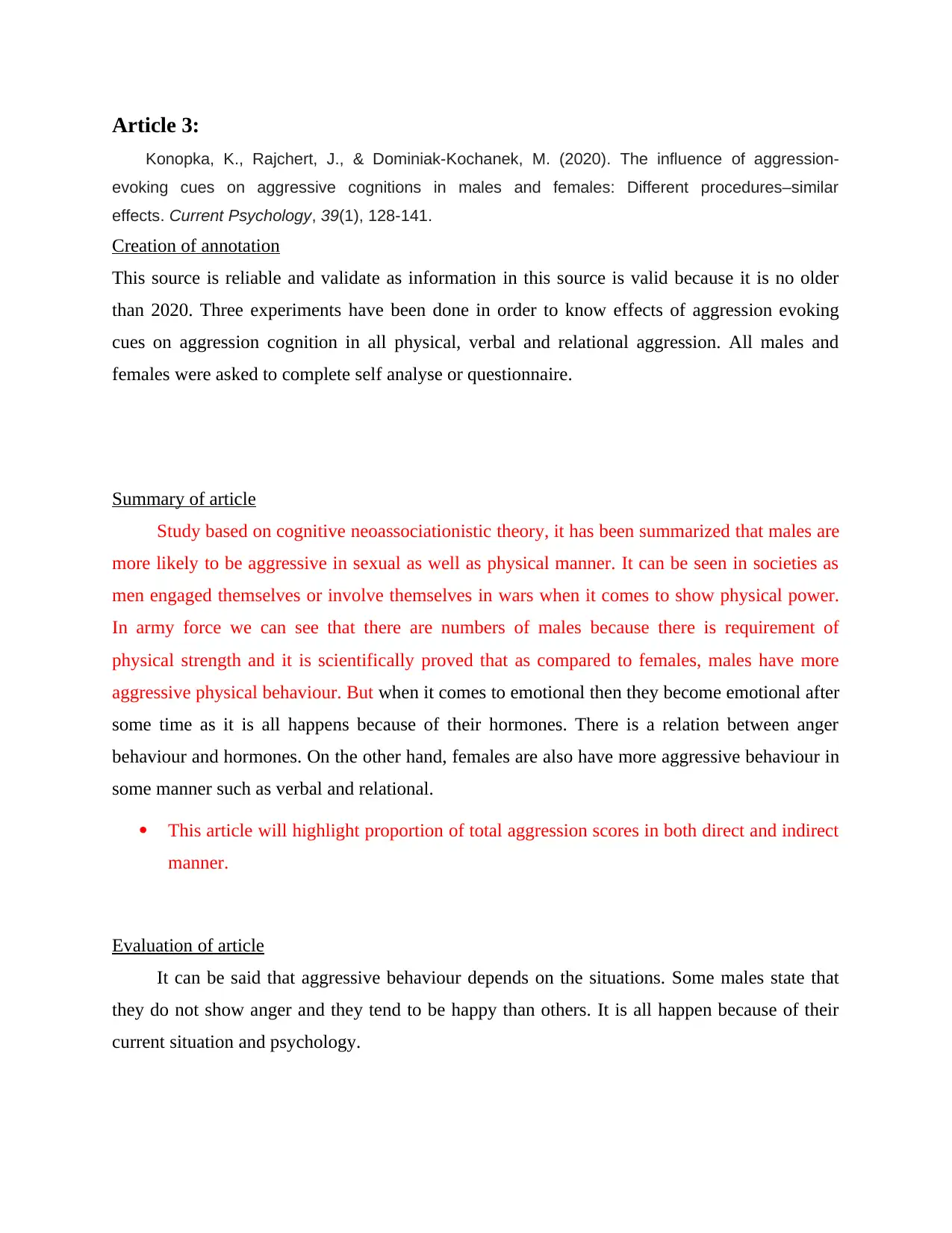
Article 3:
Konopka, K., Rajchert, J., & Dominiak-Kochanek, M. (2020). The influence of aggression-
evoking cues on aggressive cognitions in males and females: Different procedures–similar
effects. Current Psychology, 39(1), 128-141.
Creation of annotation
This source is reliable and validate as information in this source is valid because it is no older
than 2020. Three experiments have been done in order to know effects of aggression evoking
cues on aggression cognition in all physical, verbal and relational aggression. All males and
females were asked to complete self analyse or questionnaire.
Summary of article
Study based on cognitive neoassociationistic theory, it has been summarized that males are
more likely to be aggressive in sexual as well as physical manner. It can be seen in societies as
men engaged themselves or involve themselves in wars when it comes to show physical power.
In army force we can see that there are numbers of males because there is requirement of
physical strength and it is scientifically proved that as compared to females, males have more
aggressive physical behaviour. But when it comes to emotional then they become emotional after
some time as it is all happens because of their hormones. There is a relation between anger
behaviour and hormones. On the other hand, females are also have more aggressive behaviour in
some manner such as verbal and relational.
This article will highlight proportion of total aggression scores in both direct and indirect
manner.
Evaluation of article
It can be said that aggressive behaviour depends on the situations. Some males state that
they do not show anger and they tend to be happy than others. It is all happen because of their
current situation and psychology.
Konopka, K., Rajchert, J., & Dominiak-Kochanek, M. (2020). The influence of aggression-
evoking cues on aggressive cognitions in males and females: Different procedures–similar
effects. Current Psychology, 39(1), 128-141.
Creation of annotation
This source is reliable and validate as information in this source is valid because it is no older
than 2020. Three experiments have been done in order to know effects of aggression evoking
cues on aggression cognition in all physical, verbal and relational aggression. All males and
females were asked to complete self analyse or questionnaire.
Summary of article
Study based on cognitive neoassociationistic theory, it has been summarized that males are
more likely to be aggressive in sexual as well as physical manner. It can be seen in societies as
men engaged themselves or involve themselves in wars when it comes to show physical power.
In army force we can see that there are numbers of males because there is requirement of
physical strength and it is scientifically proved that as compared to females, males have more
aggressive physical behaviour. But when it comes to emotional then they become emotional after
some time as it is all happens because of their hormones. There is a relation between anger
behaviour and hormones. On the other hand, females are also have more aggressive behaviour in
some manner such as verbal and relational.
This article will highlight proportion of total aggression scores in both direct and indirect
manner.
Evaluation of article
It can be said that aggressive behaviour depends on the situations. Some males state that
they do not show anger and they tend to be happy than others. It is all happen because of their
current situation and psychology.
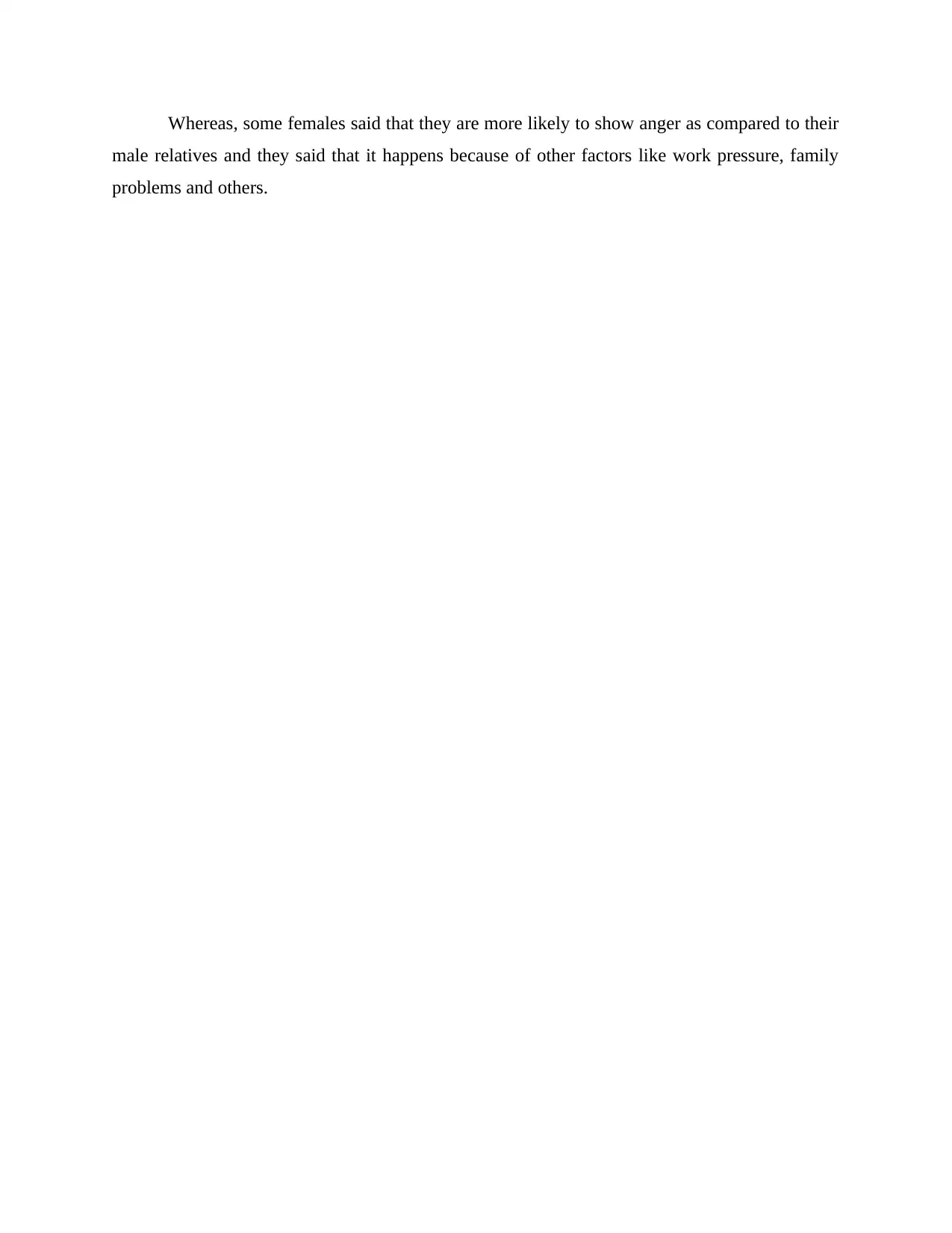
Whereas, some females said that they are more likely to show anger as compared to their
male relatives and they said that it happens because of other factors like work pressure, family
problems and others.
male relatives and they said that it happens because of other factors like work pressure, family
problems and others.
⊘ This is a preview!⊘
Do you want full access?
Subscribe today to unlock all pages.

Trusted by 1+ million students worldwide
1 out of 6
Related Documents
Your All-in-One AI-Powered Toolkit for Academic Success.
+13062052269
info@desklib.com
Available 24*7 on WhatsApp / Email
![[object Object]](/_next/static/media/star-bottom.7253800d.svg)
Unlock your academic potential
Copyright © 2020–2025 A2Z Services. All Rights Reserved. Developed and managed by ZUCOL.



